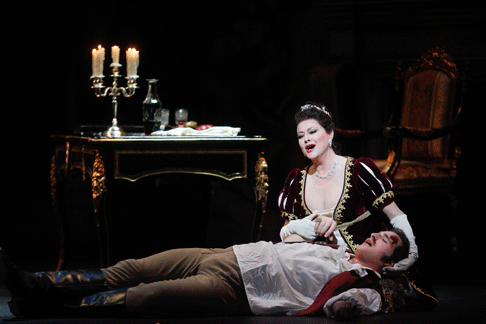03 Apr 2011
Tosca, Palm Beach
Victorien Sardou wrote the melodrama La Tosca, a play subject to all sorts of incidental drama and off-stage intrigue, for Sarah Bernhardt.

Victorien Sardou wrote the melodrama La Tosca, a play subject to all sorts of incidental drama and off-stage intrigue, for Sarah Bernhardt.
In a representative case of truth at least rivaling fiction, there were dime-novel circumstances revolving around the play even before “the most famous actress the world has ever known” took the stage, the first Floria Tosca.
For one thing, the whole of the thing was set under the specter of legal issues – another author claimed that Sardou had cribbed the story (those days in theater circles, this was not an altogether uncommon accusation). The show would go on. Bernhardt saw to this herself as partial financier; she rented the theater where the play would debut in 1887.
The plot twists further when Bernhardt learns Sardou made arrangements to have another actress play La Tosca in the stateside premiere. Bernhardt’s threats to desert probably rang hollow; she was overinvested; the theater and the man (her lover) playing Baron Scarpia were hers. Bernhardt’s eventual change of heart aligned her with a calamity of fate, one joined to Floria Tosca’s own. Touring the play in Brazil, she injured herself in performance and eventually lost a limb. La Tosca, as you know, in the hands of Giacomo Puccini, would become the opera Tosca.
There were no such fractures in Palm Beach Opera’s Tosca (seen March 25th). Breaks of the dramatic variety, however, did happen.
It is unclear whether Director Massimo Gasparon’s concepts or the execution of these were faulty. One thing is clear, the acting of the principals tended towards predictable and slack, and in some cases limited in scope. Scarpia’s assault on Tosca is a case in point – more like timid mud-wrestling, the two seemed unsure of how to go about taking the actions of their respective motivations.
The troublesome stage activities seeped into the music and into the pit. Maestro Bruno Aprea showed the bearings of a trooper; through tripped-up entrances and marred text, the conductor mouthed along with singers and kept the music flowing – slowly. What is more, the orchestra pulled out very rich timbres and evenly wound textures. This instrumental balance gave way to the most sprawling soundscapes in act one: for the entire scene of Angelotti’s reappearance and the soaring lines of the duet.
The chorus – prepared by Greg Ritchey – turned in a strong vocal performance in the “Te Deum” and some often over-shadowed musical bits were gleaned from Tosca’s recital.
There were moments when Chiara Taigli seemed miscast in the role of Tosca, her voice a hair light in the middle, with but a touch of steel at top. Her “Vissi d’arte” was labored as Aprea seemed to take things slower still. At the word “assassino” in the second act, Taigli’s stage manner turned more sure and the use of her hands in the final act duet was striking.
Tenor Riccardo Massi has had some important engagements overseas of late. As Cavaradossi here, Massi’s easy high notes complimented a weighted sound that sped through “E lucevan le stelle.” Massi demonstrated he could sing a legato line though there were few instances of him doing it.
 Chiara Taigi as Tosca and Riccardo Massi as Cavaradossi
Chiara Taigi as Tosca and Riccardo Massi as Cavaradossi
Claudio Sgura appeared to be taking cues from Tito Gobbi’s acting grab bag; the baritone mainly used his eyes to convey wickedness as Scarpia. Sgura’s singing was one-dimensional, an attractive dimension though it is.
Matteo Peirone returns to PBO as Il sagrestano, with a big moment corralling choir boys just before the “Te Deum.” Mathew Burns’ played a woozy Angelotti. Young Artist Evanivaldo Correa Serrano’s Spoletta was obliging to his master Scarpia. With a sharp turn and genuflection towards his liege, as Sciarrone Young Artist Kenneth Stavert’s actions were as if half-mocking Scarpia. Gasparon has the Shepherd Boy – on this night Young Artist Greta Ball, trying her darndest to sing out of vibrato – sitting on the ramparts of Castel Sant'Angelo and shooed away by guards after his paen to the morning.
PBO borrows these sets for Tosca from Sarasota Opera; they were created by Sarasota’s resident scenic designer David P. Gordon. Gordon’s take on Castel Sant'Angelo includes a backdrop (lit by Joseph R. Oshry) view of St. Peter’s Basilica and Vatican City.
Taigli’s suspenseful swinging of her cape before diving from Sant’Angelo’s parapets ended Tosca in better dramatic form than had been the night’s pattern. Incidentally, it was on this fall that Bernhardt shattered her right knee in La Tosca.
Robert Carreras